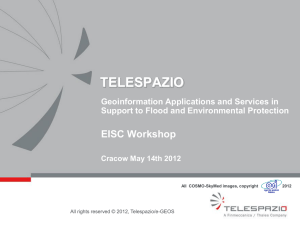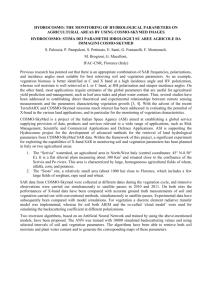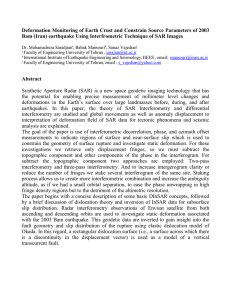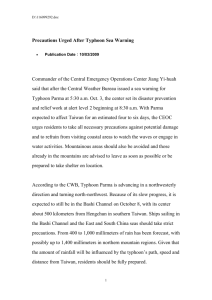Document 11870027
advertisement
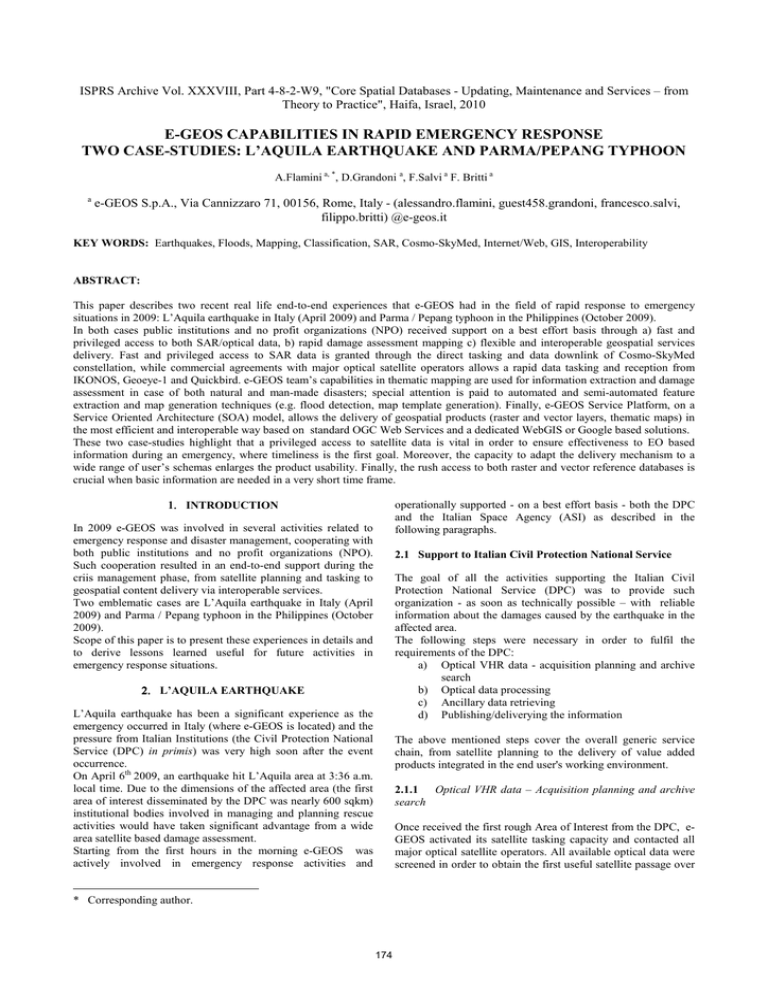
ISPRS Archive Vol. XXXVIII, Part 4-8-2-W9, "Core Spatial Databases - Updating, Maintenance and Services – from Theory to Practice", Haifa, Israel, 2010 E-GEOS CAPABILITIES IN RAPID EMERGENCY RESPONSE TWO CASE-STUDIES: L’AQUILA EARTHQUAKE AND PARMA/PEPANG TYPHOON A.Flamini a, *, D.Grandoni a, F.Salvi a F. Britti a a e-GEOS S.p.A., Via Cannizzaro 71, 00156, Rome, Italy - (alessandro.flamini, guest458.grandoni, francesco.salvi, filippo.britti) @e-geos.it KEY WORDS: Earthquakes, Floods, Mapping, Classification, SAR, Cosmo-SkyMed, Internet/Web, GIS, Interoperability ABSTRACT: This paper describes two recent real life end-to-end experiences that e-GEOS had in the field of rapid response to emergency situations in 2009: L’Aquila earthquake in Italy (April 2009) and Parma / Pepang typhoon in the Philippines (October 2009). In both cases public institutions and no profit organizations (NPO) received support on a best effort basis through a) fast and privileged access to both SAR/optical data, b) rapid damage assessment mapping c) flexible and interoperable geospatial services delivery. Fast and privileged access to SAR data is granted through the direct tasking and data downlink of Cosmo-SkyMed constellation, while commercial agreements with major optical satellite operators allows a rapid data tasking and reception from IKONOS, Geoeye-1 and Quickbird. e-GEOS team’s capabilities in thematic mapping are used for information extraction and damage assessment in case of both natural and man-made disasters; special attention is paid to automated and semi-automated feature extraction and map generation techniques (e.g. flood detection, map template generation). Finally, e-GEOS Service Platform, on a Service Oriented Architecture (SOA) model, allows the delivery of geospatial products (raster and vector layers, thematic maps) in the most efficient and interoperable way based on standard OGC Web Services and a dedicated WebGIS or Google based solutions. These two case-studies highlight that a privileged access to satellite data is vital in order to ensure effectiveness to EO based information during an emergency, where timeliness is the first goal. Moreover, the capacity to adapt the delivery mechanism to a wide range of user’s schemas enlarges the product usability. Finally, the rush access to both raster and vector reference databases is crucial when basic information are needed in a very short time frame. 1. INTRODUCTION operationally supported - on a best effort basis - both the DPC and the Italian Space Agency (ASI) as described in the following paragraphs. In 2009 e-GEOS was involved in several activities related to emergency response and disaster management, cooperating with both public institutions and no profit organizations (NPO). Such cooperation resulted in an end-to-end support during the criis management phase, from satellite planning and tasking to geospatial content delivery via interoperable services. Two emblematic cases are L’Aquila earthquake in Italy (April 2009) and Parma / Pepang typhoon in the Philippines (October 2009). Scope of this paper is to present these experiences in details and to derive lessons learned useful for future activities in emergency response situations. 2.1 Support to Italian Civil Protection National Service The goal of all the activities supporting the Italian Civil Protection National Service (DPC) was to provide such organization - as soon as technically possible – with reliable information about the damages caused by the earthquake in the affected area. The following steps were necessary in order to fulfil the requirements of the DPC: a) Optical VHR data - acquisition planning and archive search b) Optical data processing c) Ancillary data retrieving d) Publishing/deliverying the information 2. L’AQUILA EARTHQUAKE L’Aquila earthquake has been a significant experience as the emergency occurred in Italy (where e-GEOS is located) and the pressure from Italian Institutions (the Civil Protection National Service (DPC) in primis) was very high soon after the event occurrence. On April 6th 2009, an earthquake hit L’Aquila area at 3:36 a.m. local time. Due to the dimensions of the affected area (the first area of interest disseminated by the DPC was nearly 600 sqkm) institutional bodies involved in managing and planning rescue activities would have taken significant advantage from a wide area satellite based damage assessment. Starting from the first hours in the morning e-GEOS was actively involved in emergency response activities and The above mentioned steps cover the overall generic service chain, from satellite planning to the delivery of value added products integrated in the end user's working environment. 2.1.1 Optical VHR data – Acquisition planning and archive search Once received the first rough Area of Interest from the DPC, eGEOS activated its satellite tasking capacity and contacted all major optical satellite operators. All available optical data were screened in order to obtain the first useful satellite passage over * Corresponding author. 174 ISPRS Archive Vol. XXXVIII, Part 4-8-2-W9, "Core Spatial Databases - Updating, Maintenance and Services – from Theory to Practice", Haifa, Israel, 2010 satellite image - to DPC approximately at 05.00 a.m (April the 7th, , 26.5 hours after the earthquake). the AOI, that resulted from IKONOS satellite (10.00 a.m. ca). Taking advantage from running commercial agreements, eGEOS was capable to schedule the acquisition of that passage granting the access to an image acquired within 6 hours from the earthquake. In the meanwhile, Very High Resolution (VHR) pre-event orthoimages were retrieved from e-GEOS archives. Such orthoimages were acquired during an aerial photogrammetric survey in 2007 and have a spatial resolution of 50cm outside L'Aquila municipality and 20cm within the urban area. The availability of accurate and high resolution pre-event images resulted essential since allowed the change detection analysis for damage assessment. All the pre event and reference data were immediately made available to the DPC and harmonized in their collaborative environment (see par. 2.1.4 Publishing/deliverying the information). 2.1.2 Optical data processing Figure 2 Product example: damaged and collapsed buildings over IKONOS pansharpened image (06.04.2009) The first post-event image from IKONOS satellite was delivered by the satellite operator to e-GEOS on a dedicated FTP site at around 5 p.m. The IKONOS panchromatic image was downloaded and after that orthorectified using the appropriate sensor model, Ground Control Points extracted from available accurate orthoimages and a 20m grid size DEM available in house. After a quick basic visual quality control of the accuracy of the orthorectified image with respect to the reference one, the image itself was radiometrically corrected in order to enhance visual interpretation possibilities. 2.1.3 Ancillary data retrieving Another key issue that arises while supporting entities involved in the management of emergency situations is the access to detailed, reliable and updated ancillary data such as infrastructure (e.g. road and rail) networks in order to correctly handle logistic aspects and deploy operational teams in field. Thanks to a consolidated commercial cooperation with Navteq, e-GEOS could provide DPC with the most updated road and rail network (2009). 2.1.4 Publishing/deliverying the information Since the very first hours after the event, DPC set up a collaborative space where all helpful informative layers provided by different actors could be integrated and shared as standard OGC Web services. Interoperability was a key issue as many different actors were feeding DPC Situation Centre with several layers, possibly being not usable due to the significant harmonization effort that heterogeneous data sources would have required – apart from the time consuming data transfer operation. Given this scenario, e-GEOS exploited its own Web Mapping capabilities and set up a dedicated WMS on its own servers to host all the layers that were retrieved (Navteq road&rail network, pre-event orthophoto coverage) and produced (IKONOS post-event image, change detection analysis vector layer) by e-GEOS during the first 24 hours after the earthquake. Figure 1 IKONOS post event orthorectified image (06.04.2009) This basic processing steps were completed in a couple of hours, being the very first post-event image ready for visual interpretation on April the 6th, at 08.00 p.m. approximately (16.5 hours after the event). Finally, IKONOS image was visually interpreted by a group of expert optical visual interpreters in order to identify partially and completely collapsed buildings over the AOI provided by DPC, prioritizing the analysis in areas where information about damages caused by the earthquake had not been delivered yet . The change detection procedure was based on the comparison between the pre and post event images and was performed using a common COTS GIS software, exploiting a dedicated configuration allowing simultaneous editing of the same database by different operators, . The output of the visual interpretation process was a punctual vector layer that was delivered – together with the IKONOS Figure 3 IKONOS post event orthorectified image and punctual identification of damaged and collapsed buildings 175 ISPRS Archive Vol. XXXVIII, Part 4-8-2-W9, "Core Spatial Databases - Updating, Maintenance and Services – from Theory to Practice", Haifa, Israel, 2010 A missing or inaccurate archive analysis would have affected all the subsequent activities not allowing interferometric processing and coherence analysis due to the absence of interferometric pairs. The information of acquisition details of archive scenes was used in the screening phase of all the available Data Take Opportunities (DTO) over L'Aquila area of the week after the earthquake. Whenever possible, co-seismic pairs (pre and post earthquake images acquired under the same geometric conditions) were planned. Starting from the 6th of April, up to three images (Spotlight-2 and Himage mode) per day were regularly acquired over the Area of Interest (see Figure 5). The WMS was designed in order to be compliant with the specifications requested by DPC (naming convention, supported reference systems) and the layers available in e-GEOS Web Mapping Service were easily integrated in the collaborative DPC web portal. 2.2.2 Thanks to the direct link with Cosmo-SkyMed operational ground stations (Matera, Kiruna and Cordoba), all the acquired Cosmo-SkyMed images where processed as soon as the focussed products (Single Look Complex) were available at the station and transferred at e-GEOS Emergency Room in Rome. All data were processed until Level 1-D (Ground Terrain Corrected) using the available orbit parameters and a 20m posting DEM. A preliminary accuracy analysis performed using VHR aerial images as geometric reference showed a geometric accuracy - variable according to the image incidence angle (the lower the angle, the higher the error) – ranging from 4m and 12m RMSE for images acquired in Himage mode (3m GSD, 40km swath)1. Whenever possible, different interferometric products were generated such as a) ILU (Interferometric Land Use Image), b) MTC (Coherent Multitemporal Image) and c) co-seismic interferograms and Interferometric Browse Product (IBP). ILU and MTC products are false colour composite images realized through linear combinations of the SAR detected amplitudes and the interferometric coherence of two SAR images acquired in interferometric mode (i.e. same orbit pass, look direction, incidence angle, polarization) In details, ILU product exploits the following combination: • Red: interferometric coherence • Green: mean SAR detected amplitude value computed within the two acquisition • Blue: absolute value of the difference between SAR detected amplitude values in the two images Figure 4 DPC web portal with e-GEOS (former Telespazio) layers integration 2.2 Support to Italian Space Agency In the meanwhile, e-GEOS operationally supported the Italian Space Agency (ASI) in exploiting Cosmo-SkyMed capabilities to support the actors involved in rescue activities. The actions undertaken by e-GEOS were: a) b) c) Data processing Cosmo-SkyMed acquisition planning and archive search; Data processing; Web portal hosting and management. 2.2.1 Cosmo-SkyMed acquisition planning and archive search The archive search and analysis was the very first basic task performed by e-GEOS in order to streamline Cosmo-SkyMed new acquisitions best fitting with pre event scenes and coupling them in interferometric pairs. This preliminary operation proved to be essential as available pre-event scenes covered only a limited range of all the possible Cosmo-SkyMed acquisition modes, looking angles, pass directions and beams. Figure 6 MTC change detection analysis (05.04.09 - 14.04.09) Figure 5 Cosmo-SkyMed acquisitions footprint (6-20.04.2009) 1 176 This error estimation is consistent with Cosmo-SkyMed product specifications. ISPRS Archive Vol. XXXVIII, Part 4-8-2-W9, "Core Spatial Databases - Updating, Maintenance and Services – from Theory to Practice", Haifa, Israel, 2010 On the other hand, MTC product is generated by this combination: • Red: SAR detected amplitude value of master image (1st acquisition) • Green: SAR detected amplitude value of slave image (2nd acquisition) • Blue: interferometric coherence Both products are mainly used for change detection and thematic mapping analysis as their main capability is to highlight both areas where coherence is high (e.g. human infrastructues that have not changed (buldings, roads, …) and areas where changes happened (e.g. damaged buildings, new tent camps). 3. PARMA/PEPANG TYPHOON (PHILIPPINES) Parma typhoon has been a valuable test bed in order to try out a complex service value chain bringing together private sector actors (e-GEOS), no profit organizations (Ithaca) and public organizations (World Food Program – WFP). On October 2nd 2009, Parma typhoon passed over Northern Philippines causing significant flooding. These were the most significant phases of the response to the emergency: a) b) c) d) e) f) 3.1.1 Early Warning The foreseen ground track of tropical typhoons is regularly monitored by different meteorological organizations. Early warning is a key issue to facilitate a timely access to both optical and SAR EO data as generally time requested for the first post event satellite image is the major cause of delay in damage assessment products provision. Although the availability of a certain number of commercial and non commercial satellite missions and a satellite constellation such as Cosmo-SkyMed can reduce the timelines for obtaining the very first post event satellite acquisition, anticipation and early warning is the preferred solution. Whenever possible (e.g. floods caused by typhoons, cyclones and heavy rains) all early warning systems should be used in order to anticipate the event and make possible the acquisition of both pre and post event images within the shortest time frame; this will ease damage assessment activities. Moreover, a regular archive update of crisis prone areas (e.g Southern Bangladesh or Philippines for flood events) is definitely a top priority for the organization involved in the emergency management since allows rescue teams and crisis rooms to quickly access backgorund reference information in the very few hours after the event. Figure 7 Cosmo-SkyMed interferogram (23.03.09 - 08.04.09) Co-seismic interferograms (Monti Guarnieri et al., 2002) enable a terrain displacement analysis comparing the interferometric phase of pre and post event images. In this case the first available interferometric pair was a Himage (3m ground resolution) pair dating 23.03.2009 – 08.04.2009. The preliminary analysis of this images showed in some areas up to two consecutive cycles of interferometric fringes, that is a relative rough displacement of 3cm (X-band wavelenght) along the satellite line of sight. The Interferometric Browse Product (IBP) is a useful tool for interferograms display and analysis, as it combines in a single image both SAR amplitude images and interferograms: when the interferometric coherence is above a certain threshold (e.g. 0.2) the interferogram is displayed; elsewhere the one of the two SAR detected amplitude images is used. All the products were 3D rendered using a 20m DEM in order to highlight possible topographic effects. 2.2.3 Early Warning: Cosmo-SkyMed fast programming: Cosmo-SkyMed fast processing: Flood area dynamics – Draw off (Vector extraction) Vector integration and map generation: Publication Web portal hosting and management Immediately after the earthquake ASI asked e-GEOS to set up a dedicated Web-GIS under ASI brand in order to act as a showcase of all Cosmo-SkyMed products available after the earthquake. This request was quickly satisfied exploiting e-GEOS web infrastructure and its standard processing chain for Web-GIS, resulting in an active and updated OGC compliant Web-GIS ready in a couple of hours from the request. The Web-GIS contained a set of basic layers such as recent VHR aerial orthoimages coverage (50cm ground resolution), adiministrative boundaries and toponyms and Navteq road&rail network. The Web-GIS continued to host all the products that were available thanks to the no-stop processing of the latest CosmoSkyMed acquisitions (up to four per day in Himage mode). Figure 8 Area of Interest for Parma/Pepang typhoon In this specific case an early warning about the passage of a very strong typhoon (Parma/Pepang) was raised by WFP and 177 ISPRS Archive Vol. XXXVIII, Part 4-8-2-W9, "Core Spatial Databases - Updating, Maintenance and Services – from Theory to Practice", Haifa, Israel, 2010 registration among the different images and an acceptable RMSE compared with both Landsat 7 ETM+ orthorectified imagery available from Global Land Cover Facility2 and VHR images available in Google Earth©. transmitted through Ithaca to e-GEOS on October the 1st, raising the issue of a Cosmo-SkyMed rapid tasking over the selected AOI (North-East area of Luzon island - Philippines). The AOI definition is an important issue especially when different EO based mechanisms operating during both man made and natural emergencies (e.g. International Charter “Space and Major Disasters”, pre-operational version of GMES Emergency Response Service) are triggered simultaneously during a single large event. Coordination and resources streamlining are aspects of paramount importance, in particular a correct management of AOI assignment to each running Emergency Response initiative is the key to get information over larger parts of the crisis affected area. 3.1.2 3.1.4 Flood area dynamics – Draw off (Vector extraction) Cosmo-SkyMed constellation gives the possibility to improve Emergency service production in flood monitoring thanks to a) revisit time (multiple Data Take Opportunities per day), b) X band , c) polarimetric capacity and d) very high spatial resolution. e-GEOS Emergency Room team tested water surfaces extraction over different area in order to improve its capability to provide a faster rapid mapping service to produce floods maps. Test cases in 2009 are listed in the table below. Cosmo-SkyMed fast programming e-GEOS immediately activated its tasking facility and scheduled a daily Cosmo-SkyMed ScanSAR Wide Region acquisition (30m ground resolution, 100km swath) over the indicated AOI, starting from October the 2nd, one day after the triggering. The choice of ScanSAR Wide Region acquisition mode resulted from a) the best compromise between geometric resolution and image swath - being the typhoon affected area much extended – and b) the only acquisition mode that guaranteed a complete AOI coverage with at least one passage per day. A sequence of three Cosmo-SkyMed images was acquired (2-34.10.2009) during the most critical time period, allowing multitemporal flood dynamics analysis over the AOI as the strongest typhoon passage effects were visible on the image acquired on the 3rd of October. All the images were available in standard Single Look Complex format (Level.1-B) within 12 hours after the acquisition. Area Date Typhoon/Cyclone Bangladesh May 2009 Aila Manila (MMA3) Sept. 2009 Ondoy Ketsana Manila (MMA) Oct. 2009 Lupit Philippines Oct. 2009 Parma/Pepang Philippines Oct. 2009 Santi Table 1 Flooding test cases in 2009 e-GEOS Emergency Room team developed different methods based on algorithms implemented in available COTS software for the automatic extraction of water surfaces from SAR data (AA.VV., 2009). In details: a) Water surface extraction with SAR detected amplitude data using a pixel-based method : I. Radiometric and minimum size threshold; II. K-means clustering (Tou et al., 1974), b) Water surface extraction using an object-based method, Figure 9 Cosmo-Skyfootprints (02-03-04.10.2009) 3.1.3 Cosmo-SkyMed fast processing Thanks to the direct and exclusive link that e.-GEOS has in place with Cosmo-SkyMed operational ground stations (Matera, Kiruna and Cordoba), all the images were immediately transferred at e-GEOS Emergency Room and then processed to the requested processing level. Each scene was geometrically corrected (Level 1-D) and radiometrically calibrated and normalized (Frei et al., 1993) in order to ensure the maximum radiometric homogeneity among the scenes, considering that two scenes were acquired in pseudo tandem mode (same acquisition geometry, one day temporal interval). All the scenes were geocoded using NASA SRTM90 as reference Digital Elevation Model, ensuring good co- Figure 10 Observable water surface on Cosmo-SkyMed image (03.10.2009) In the Parma case study each scene was processed in order to extract visible water surface and therefore to depict flood dynamics during the passage of the typhoon comparing the pre event scene (October the 2nd) and the two post event scenes (October the 3rd and the 4th) using a-II) and b) methods. 2 3 178 www.landcover.org Manila Metropolitan Area ISPRS Archive Vol. XXXVIII, Part 4-8-2-W9, "Core Spatial Databases - Updating, Maintenance and Services – from Theory to Practice", Haifa, Israel, 2010 4. CONCLUSIONS All the vector layers were then delivered to Ithaca for the map generation. In conclusion water bodies extraction can be realized by eGEOS Rapid mapping team from Cosmo Sky Med data: a) In a short time (3 h from the satellite data availability ) b) Automatically, c) With few false detection; d) And independently from weather condition, Some difficulties arise in the classification of urban areas and riparian vegetation where backscattering problems occur (Richards et al., 1987). Moreover, layover and shadow effects may cause false detection problems, that can be partially solved using automated layover/shadow mask generation techniques (Walter et al., 1990). In these area e-GEOS Emergency Room team is currently working to improve the flood detection analysis. 3.1.5 These two case studies (L'Aquila earthquake and Parma/Pepang typhoon) demonstrate that a privileged access to satellite data is vital in order to ensure effectiveness to EO based information during an emergency situation, when timelines is the first goal. Early warning mechanisms – especially for well known and somehow predictable natural disasters - are essential for shortening as much as possible the time lag between the event occurrence and the first post event image availability Moreover, the capacity to adapt the delivery mechanism to a wide range of user’s schemas enlarges the product usability. Service Oriented Architecture (SOA) models such as the use of OGC standard Web Services grants interoperability capabilities in collaborative environments in which different sources of information must be put together as quickly as possible and with the lowest resources consumption. Finally, the rush access to both raster and vector reference databases is crucial when basic information are needed in a very short time frame. In particular, a wise population of CosmoSkyMed archive in crisis prone areas and the refinement of acquisition planning techniques could foster the efficiency of geoinformation in disaster management operations. Vector integration and map generation Layers resulting from visual interpretation and automatic feature extraction were integrated in a map template with basic layers and other information. The generation of assessment maps requires a great variety of activities which mean too long time for the response: searching for data in the area of interest, elaboration of vector and raster layers, to assign symbology, and so on. In order to reduce the time spent in these activities, a World Geospatial Database (WGD) was carried out based on open source data. The WGD contains vector and raster data, covering all over the World, organized in a structure which allows a rapid search and usage of layers. Layers of networks (road, railroad, river, power, etc.), inland water, cities, industry installations, soil, vegetation, elevation, toponyms and many other features can be loaded in an automated template with a predefined symbology. Data in the WGD are divided in two blocks according to the scale of representation. Such a complete and wide set of data could be useful not only for the quick generation of maps but as support for visual interpretation of images and feature extraction. 5. REFERENCES AA.VV., 2009, D331-2:Emergencies FTS – Validation scenarios report – Final version, BOSS4 GMES Project No. SIP5-CT-2006-031022. Frei U., C. Graf ,E. Meier: "Cartographic Reference Systems, SAR Geocoding". Data and System, Wichmann Verlag, 1993. Monti Guarnieri A., Cafforio C., Guccione P., Nüesch D., Small D., Meier E., Pasquali P., Zink M., Desnos Y. L., Multi-mode ENVISAT ASAR Interferometry: Techniques and Preliminary Results, Proceedings of EUSAR Conference, 2002. Richards A., Woodgate P.W., Skidmore A.K., 1987, An explanation of enhanced radar backscattering from flooded forests, International Journal of Remote Sensing. Tou, J. T. and R. C. Gonzalez, 1974. Pattern Recognition Principles, Addison-Wesley Publishing Company, Reading, Massachusetts. Walter G. Kropatsch and Dieter Strobl: The Generation of SAR Layover and Shadow Maps from Digital Elevation Models. IEEE Transactions on Image Processing, Vol. 28, No. 1, January 1990. 6. ACKNOWLEDGEMENTS Figure 11 Flood affected areas map (Ithaca) 3.1.6 The Authors thank Prof. Piero Boccardo and Mr. Fabio Giulio Tonolo (Ithaca – Politecnico di Torino) for the fruitful cooperation during Parma/Pepang typhoon rapid mapping service activation. In the case of L’Aquila earthquake the Authors are grateful to the whole e-GEOS Team that showed relevant capabilities and passion in supporting relief actions after that catastrophic event. Publication The digital map was finally sent to ReliefWeb staff and published in the Map Centre section of the UN-OCHA web portal (www.reliefweb.org), providing reliable information to all the actors that could be involved in disaster management after the passage of Parma typhoon. 179
